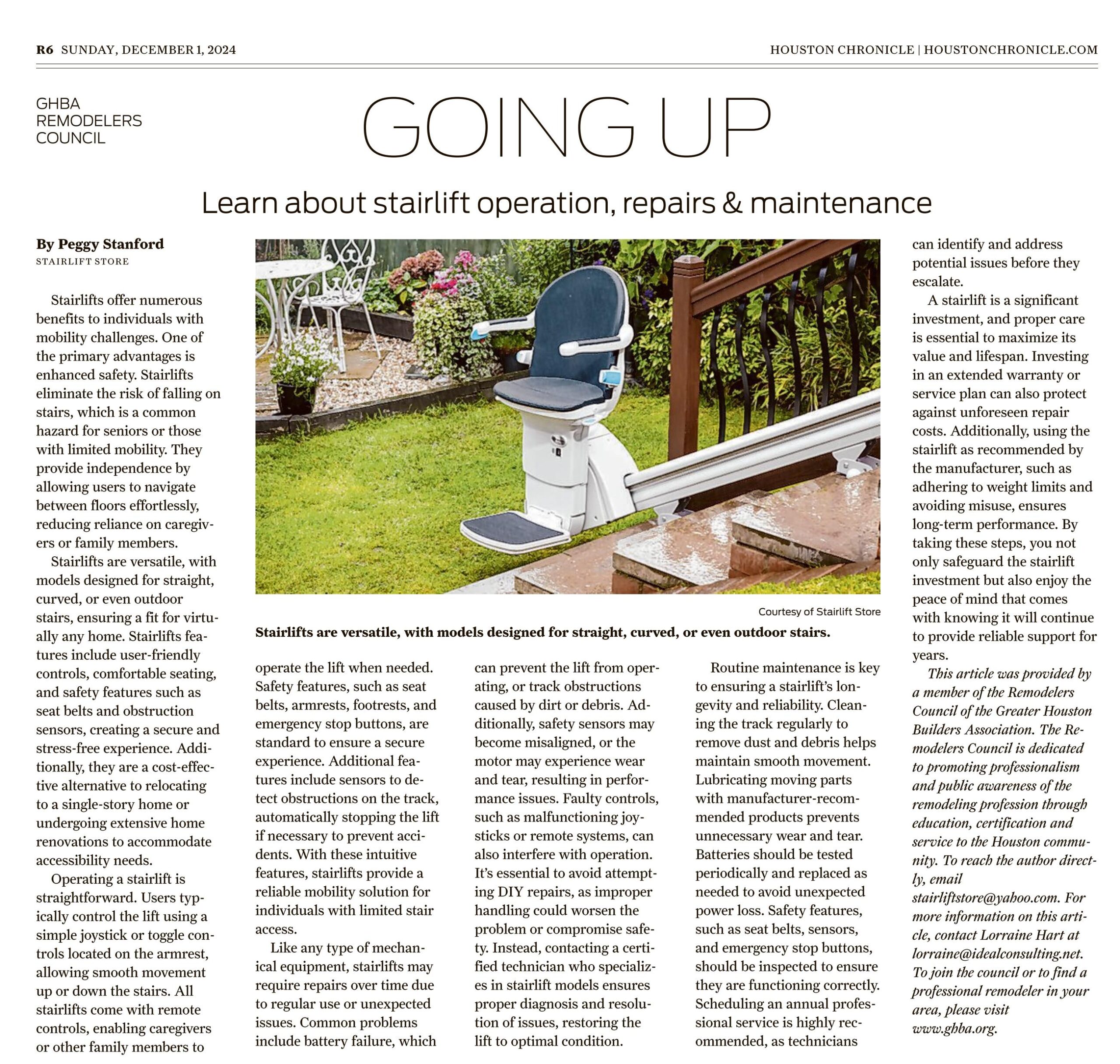Stairlift Repairs and Maintenance

This article was written by Peggy Stanford and published in the December 1, 2024 Sunday edition of the Houston Chronicle. Read online at chron.com/homes
Stairlifts offer numerous benefits to individuals with mobility challenges. One of the primary advantages is enhanced safety. Stairlifts eliminate the risk of falling on stairs, which is a common hazard for seniors or those with limited mobility. They provide independence by allowing users to navigate between floors effortlessly, reducing reliance on caregivers or family members.
Stairlifts are versatile, with models designed for straight, curved, or even outdoor stairs, ensuring a fit for virtually any home. Stairlifts features include user-friendly controls, comfortable seating, and safety features such as seat belts and obstruction sensors, creating a secure and stress-free experience. Additionally, they are a cost-effective alternative to relocating to a single-story home or undergoing extensive home renovations to accommodate accessibility needs.
Operating a stairlift is straightforward. Users typically control the lift using a simple joystick or toggle controls located on the armrest, allowing smooth movement up or down the stairs. All stairlifts come with remote controls, enabling caregivers or other family members to operate the lift when needed. Safety features, such as seat belts, armrests, footrests, and emergency stop buttons, are standard to ensure a secure experience. Additional features include sensors to detect obstructions on the track, automatically stopping the lift if necessary to prevent accidents. With these intuitive features, stairlifts provide a reliable mobility solution for individuals with limited stair access.
Like any type of mechanical equipment, stairlifts may require repairs over time due to regular use or unexpected issues. Common problems include battery failure, which can prevent the lift from operating, or track obstructions caused by dirt or debris. Additionally, safety sensors may become misaligned, or the motor may experience wear and tear, resulting in performance issues. Faulty controls, such as malfunctioning joysticks or remote systems, can also interfere with operation. It’s essential to avoid attempting DIY repairs, as improper handling could worsen the problem or compromise safety. Instead, contacting a certified technician who specializes in stairlift models ensures proper diagnosis and resolution of issues, restoring the lift to optimal condition.
Routine maintenance is key to ensuring a stairlift’s longevity and reliability. Cleaning the track regularly to remove dust and debris helps maintain smooth movement. Lubricating moving parts with manufacturer-recommended products prevents unnecessary wear and tear. Batteries should be tested periodically and replaced as needed to avoid unexpected power loss. Safety features, such as seat belts, sensors, and emergency stop buttons, should be inspected to ensure they are functioning correctly. Scheduling an annual professional service is highly recommended, as technicians can identify and address potential issues before they escalate.
A stairlift is a significant investment, and proper care is essential to maximize its value and lifespan. Investing in an extended warranty or service plan can also protect against unforeseen repair costs. Additionally, using the stairlift as recommended by the manufacturer, such as adhering to weight limits and avoiding misuse, ensures long-term performance. By taking these steps, you not only safeguard your stairlift investment but also enjoy the peace of mind that comes with knowing it will continue to provide reliable support for years to come.
